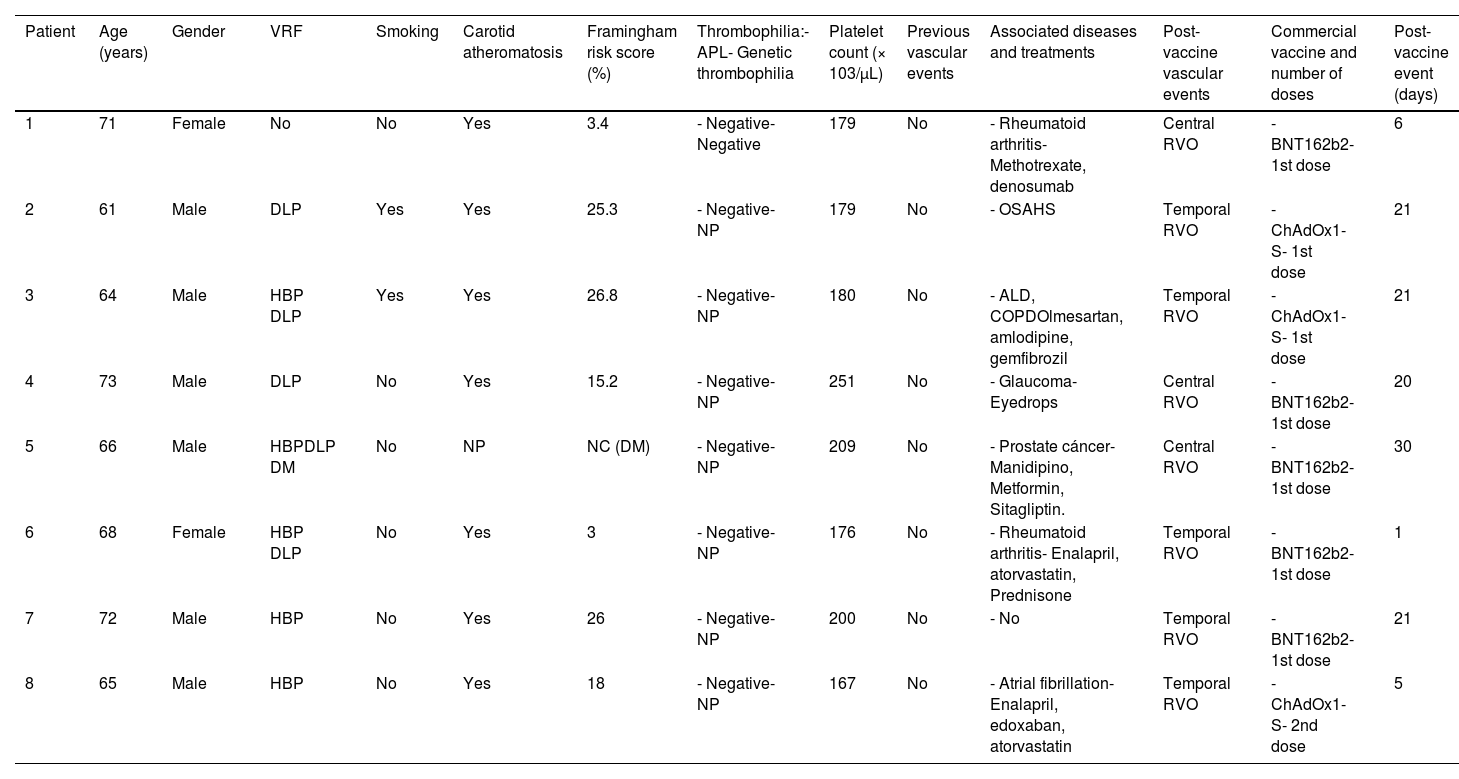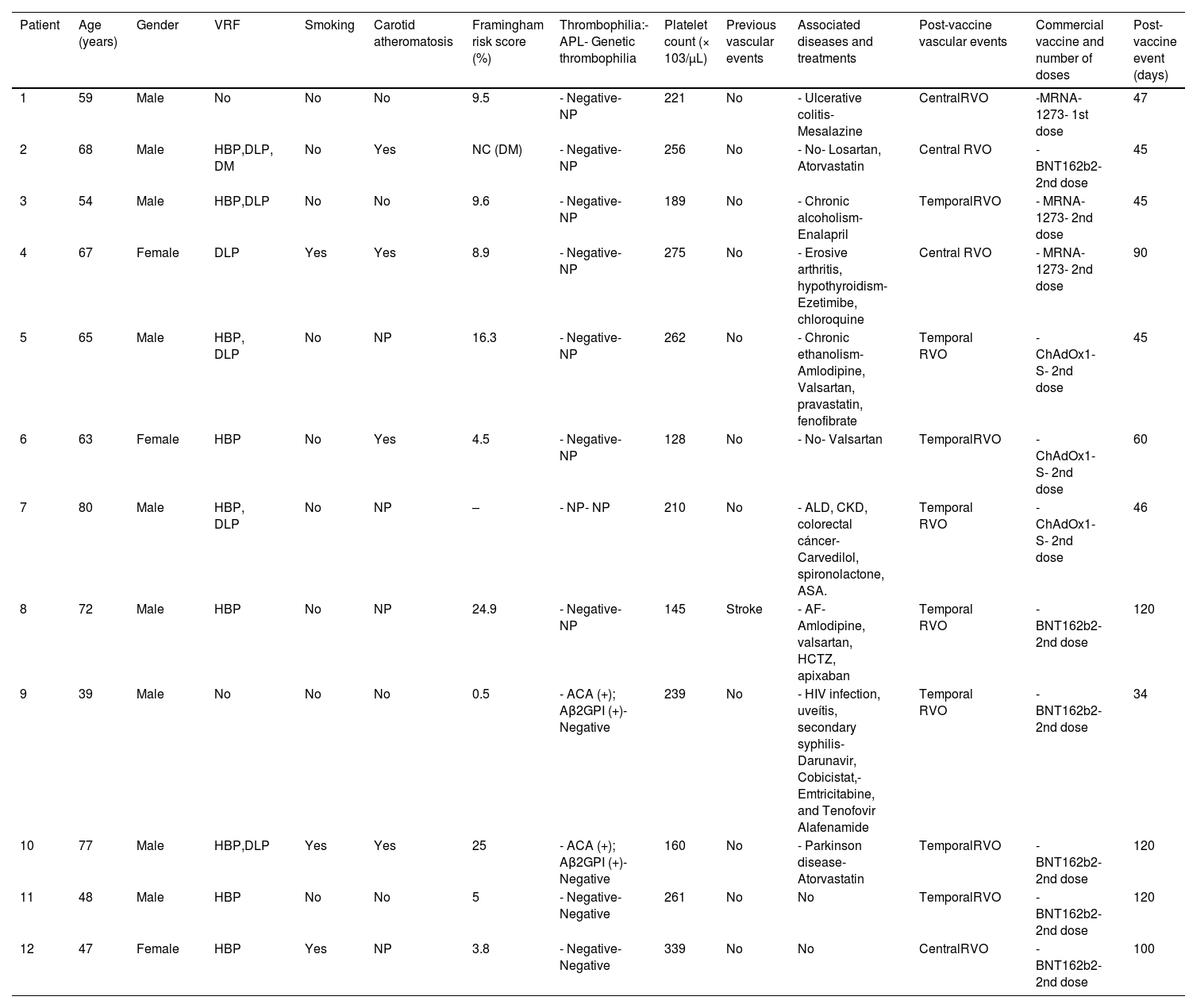Retinal vein occlusion (RVO) is mostly a consequence of vascular risk factors (VRF). COVID-19 vaccines have been related to vascular and thrombotic events (VTE).
ObjectiveTo assess the RVO incidence in the general population in our health area and the possible relation with COVID-19 infection and vaccination.
MethodsDemographic features, classic VRF, thrombophilia data, COVID-19 status, and Framingham risk score were collected prospectively.
Results472 consecutive patients studied over 13 years with RVO were included (Valdecilla Cohort). Classic VRFs were present in 90%, antiphospholipid syndrome in 12.3%, and genetic thrombophilia in 13.5%. Ninety-one percent of RVO patients were vaccinated and 6.8% suffered COVID-19 infection. In the cohort, no patient had a new RVO after vaccination or infection. In the general population, 20 subjects had RVO after receiving the vaccine (0.006%). Overall, 8 cases occurred in the first-month post-vaccination and 12 after 30 days. In the early and late groups, there are 3 and 4 patients respectively, with a low-intermediate risk Framingham score. Twenty-nine patients in the cohort suffered SARS-CoV-2 infection, twenty-seven of them had RVO before infection. Two patients with low-risk Framingham scores had RVO after infection, one of them early (<1 month).
ConclusionsVaccination and COVID-19 might be involved in the development of RVO in some cases, mainly in patients without VRF, thrombophilia, or chronic inflammatory conditions and with a lower Framingham score, especially in the first month after vaccination or infection.
La oclusión venosa retiniana (OVR) es principalmente una consecuencia de los factores de riesgo vascular (FRV). Las vacunas contra la COVID-19 se han relacionado con eventos vasculares y trombóticos (EVT).
ObjetivoEvaluar la incidencia de OVR en la población general de nuestra área de salud y su posible relación con la COVID-19 y la vacunación.
MétodosSe recopilaron prospectivamente las características demográficas, FRV clásicos, datos sobre trombofilia, padecimiento de la COVID-19 y puntuación de riesgo de Framingham.
ResultadosSe incluyeron 472 pacientes consecutivos con OVR, estudiados durante 13 años (Cohorte Valdecilla). Los FRV clásicos estaban presentes en el 90%, el síndrome antifosfolípido en el 12,3% y la trombofilia genética en el 13,5% de los casos. El 91% de los pacientes con OVR recibieron la vacuna frente a la COVID-19 y el 6.8% sufrió la infección. En la cohorte, ningún paciente tuvo una nueva OVR después de la vacunación o de la infección. En la población general, 20 sujetos presentaron OVR después de recibir la vacuna (0,006%). En general, 8 casos ocurrieron en el primer mes después de la vacunación y 12 después de 30 días. En los grupos precoz y tardío, 3 y 4 pacientes respectivamente, presentaban una puntuación de Framingham de riesgo bajo o intermedio. Veintinueve pacientes de la cohorte sufrieron infección por SARS-CoV-2 y 27 de ellos tuvieron una OVR antes de ésta. Dos pacientes con puntuaciones de Framingham de bajo riesgo presentaron una OVR después de la infección, uno de ellos precozmente (<1 mes).
ConclusionesLa vacunación y la COVID-19 podrían estar involucradas en el desarrollo de OVR en algunos casos, principalmente en pacientes sin FRV, trombofilia o procesos inflamatorios crónicos y con una puntuación de Framingham más baja, especialmente en el primer mes después de la vacunación o de la infección.








